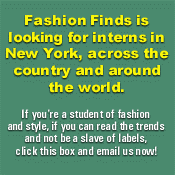
 |
|
|
Please write: dan@dancooper.tv
Return to Page One
Register here to receive Fashion Finds
email updates!

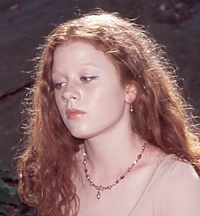 Necklace and earrings of sterling silver, freshwater pearls, garnet, rainbow moonstone, antique Czech glass, Austrian crystal, modern and antique opalescent milky glass. |
Rebecca Rockefeller: It was definitely the most difficult job I’ve ever had. The people I was working for were really wonderful; they were incredibly generous and really warm. And the kids were really wonderful kids. But it was just a little bit too much of a culture shock for me.
FF: When I was at Sarah Lawrence I had a friend who was a graduate student, she was in one of my Greek or Latin classes, I can’t remember, and her husband had a job over there. He was working for one of the oil companies.
Rebecca Rockefeller: Oh sure.
FF: And she went over there, and she could not take it because she couldn’t walk down the street without being totally harassed constantly. And she just told her husband, look I’ve just got to go home; I can’t take it.
Rebecca Rockefeller: Most westerners who go over
there live on compounds, which is where I’m sure your friend was. It’s these
little -- these odd compounds there, you know, literally walls with armed security guards
at the doors. And they’d open these electric doors and they’ll let you drive in.
And once you’re in there it’s like you’re in an American suburb from the
Fifties. And it’s very strange. The Little League, you know, baseball diamonds, and
people having barbecues and women running around in shorts.
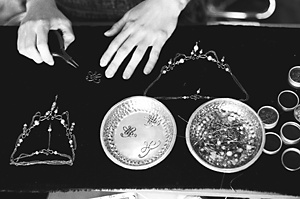 |
And then you drive out, and it’s like driving back centuries. But I wasn’t living on a compound. I was actually living in a palace with the Saudi family. So I was never harassed when I went out, because I was always with Saudis, and I had a driver who basically, when I went shopping, these housekeepers would come with me -- I was never allowed to like pick up groceries. They would always pick up what I wanted, and put it in the basket for me and ...
FF: You wouldn’t be harassed because they knew who you were working for ...
Rebecca Rockefeller: Exactly, exactly. I would have Saudi men following me around and whisper at me in Arabic, because they thought I was Syrian and they tried to, you know, "Hey, hey what’s your name? You’re very beautiful. Talk to me, just talk to me."
And I said, "No I’ll get in trouble." "Oh please, please, talk to me." So ...
FF: Sounds very intense.
Rebecca Rockefeller: It was very intense. It was actually a really fascinating experience; I think if I just could have handled it physically I would have stayed longer. But I mean, it’s 125 degrees about 85% humidity where I was in Jidda. And you have to wear full length clothing, and then over that you wear full length black silk, all over your body. I didn’t have to cover my face. But, I mean, from a physical standpoint it was almost unbearable.
And then you start internalizing all of these
things that you really don’t want to; like you’re afraid to look people in the
eye. You don’t want people brushing up against you.
 Necklace of sterling silver chain and wire work, with freshwater pearls, antique Parisian clothing ornaments. |
I think if my parents had to level one main complaint against me, it would be that I just have led a very unfocused life until lately. I just basically have been really content to just sort of let one thing turn into another and just try out a bunch of different career paths. Without any sort of clear focus in mind, which isn’t necessarily the way we should all go about life. But ...
FF: But you know, you never know. It’s sometimes the better way.
Rebecca Rockefeller: You know, it’s definitely more organic I suppose than anything else. So ...
FF: Yes, I agree. I agree. Tell me some more about when you were married.
Rebecca Rockefeller: The man that I had married was Irish, and his family lived in Liverpool.
So during about a good portion of my senior year in college I actually went over to England and lived with him and worked on my senior thesis there. And then went back a few times after that and stayed there and hung around a lot.
And I just -- I loved both there and in Saudi Arabia. I loved all of the old architecture and the old wrought iron and the old -- just the colors and the earth and the sky, and spent a lot of time in Scotland, and just saw these amazing old pubs and old houses. And I think it was all of that stuff is basically what’s turned into my jewelry.
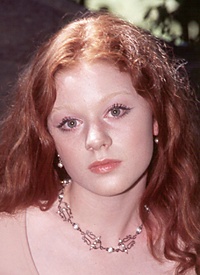 Necklace and earrings of sterling silver, freshwater pearls, Austrian crystal. |
FF: Yes. Yes. It’s interesting you say
that, because I mean I remember seeing your work for the first time. And I remember even
in the beginning, I was looking at it and thinking it’s so interesting, because
there’s an aspect that’s Venetian, in the sense of the hint of Byzantium, and
then there’s a little Renaissance, and then there’s something Celtic about it.
And then -- now I hear your story and I’m thinking well maybe -- I mean I guess
I’m hitting on it.
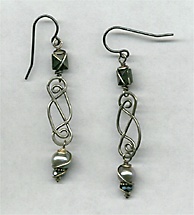 Earrings of sterling silver, hematite, antique Parisian clothing ornaments, freshwater pearls. |
Rebecca Rockefeller: Yeah no, you’ve got it right. Which is why when people try to get me to tell them exactly what I’m doing, and they say, "Well, is it Victorian?" And I say, "Well, no, not really. It’s not Victorian, it’s not Edwardian, it’s not really one thing or another," because I don’t base any of it on actual jewelry. It’s all basically just all of these images that I collected while I was traveling.
FF: Right. That’s why I think it’s so interesting, because it’s so personal.
Rebecca Rockefeller: Yeah, yeah. I hope so.
 |
FF: And so then when you came back from Saudi Arabia what ...
Rebecca Rockefeller: Well actually, one of the things that prompted me to come back was I had received a letter while I was there from a really good friend of mine whom I’d gone to college with, who was actually a physics major. And he’d been doing superconductor research. And he had started playing with Fimo and doing millefiore beads out of clay, out of Fimo. It’s a weird sort of polymer clay from Germany. And he wrote me this letter and said I’m starting this business. I know you’d be incredible at it. I want you to come back early, and work for me, and help me run this business. And I was at a point there where I was getting really tired, and I thought, "Oh all right, I’ll do it."
So I moved back, and he and his girlfriend and my husband Spike rented a house together in Seattle, and we set up this big sort of workshop in the basement where we would go down there all day and make little beads out of clay.
And you’ve probably seen a lot of teenagers wearing his beads. They have little cylindrical shapes, lots of little flowers, or like a little head and like Jimi Hendrix in the center or a little lion or a little mushroom. It’s youth art.
And it was very plastic-y, and I didn’t
like it at all. And I didn’t like the low -- not just the low end aspect of it but
the sort of mass produced and non organic substance that smelled bad when you’re
baking it in your oven. And it just -- it seemed slightly toxic to me.
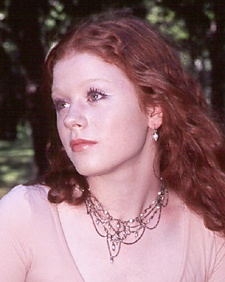 |
|
 Necklace and earrings of sterling silver, freshwater pearls, sterling silver chain. |
So it was interesting to learn how to do it, and he’s actually gone on to start a factory in China, and he’s just been selling these things all over the world. Which is pretty interesting. But I got a little bit bored of doing the Fimo, and he had met my business partner Josh, who had met a man who was opening a craft gallery in downtown Seattle, who needed a manager.
And so he basically recommended me to this man, and I interviewed with him, and he hired me to run his crafts gallery, which also had a bead bar at the back; sort of like three bar stools and a wall of beads in shot glasses. And my job was to help people who came in design jewelry, using the beads that we had there, and putting it all together for them.
And I started doing that, and as the gallery
became more and more successful, we sort of phased the beads out, and I was making jewelry
that we sold through our cases, fine jewelry cases.
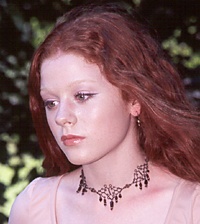 Necklace and earrings of steel, smoky topaz, garnet, sterling silver details. |
And it got to the point where I didn’t have time to help people design their jewelry any more. I was doing all this paper work, and firing and hiring and all this stuff that I didn’t like at all. And I hired a woman who had just moved to Seattle from Tucson, who is an amazing jewelry artist. And the two of us hit it off -- she’s one of my best friends.
And we had worked there together for about a year, and we’d got sent on a bead buying expedition by the owner of the store. He gave us twelve thousand dollars and sent us to the world’s largest bead show, and told us to just buy him beads. He didn’t care what we got him.
And we were like, you’ve got to be kidding. You’re going to give us twelve thousand dollars and ...
FF: You’ll never come back again.
Rebecca Rockefeller: I know. But it was the most fun I’d ever had. It was so great to spend just that much money on beads.
FF: Isn’t that nice, and it’s someone else’s money.
Rebecca Rockefeller: Someone else’s money. You know it’s not coming out of your checking account. But not a problem.
FF: What fun.
Rebecca Rockefeller: Then, while we were there,
we decided that we had just had it working for somebody else. We really wanted basically
to be in a position where we could do jewelry full time. So over a cheap bottle of tequila
we toasted our new business. We got back and quit our jobs with him, and started a jewelry
business. It was the most idiotic thing anyone could do. Everybody told us not to do it
and we did it anyway.
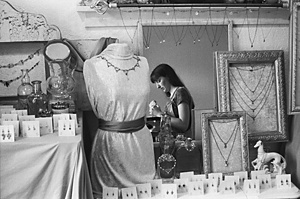 |
